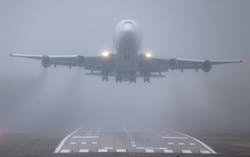Mistaken Airport Landing Could Have Put Dent In Dreamliner Production
Nov. 21--A short crisis brought on by the mistaken landing of a behemoth Boeing at a small Kansas airport could have become a much larger headache for Boeing if the plane hadn't been able to takeoff from the airport's short runway Thursday afternoon.
The 747 Dreamlifter lifted off successfully about 11:15 a.m. Pacific Time Thursday from Jabara Airport and headed immediately to its correct nearby destination, Wichita's McConnell Air Force Base.
But had pilots and engineers determined that the plane was too large to use the runway for takeoff or if it had been damaged or destroyed in landing, Boeing could have been scrambling to find a way to replace it.
The Jabara runway is 6,100 feet long. The McConnell runway stretches 12,000 feet.
The Dreamlifter involved was the second of only four modified Boeing 747-400s produced by a Taiwanese aircraft firm specifically to carry large sections of the 787's fuselage and wings among plants around the world.
Boeing says the Dreamlifter has the largest cargo hold of any aircraft in existence. The plane's fuselage diameter was enlarged by seven feet to specifically hold fuselage sections of the Dreamliner built in Italy, Wichita and South Carolina and 787 wings built in Japan. The fleet of four aircraft shuttles among those plants bringing large assemblies to final assembly plants in North Charleston, S.C. and Everett. The Dreamlifter's tail swivels out of the way while the plane is being loaded or unloaded.
Boeing opted to disperse 787 major sections production at sites around the world to reduce its own capital costs and to win political points for spreading the benefits of its production around.
In opting for the giant air freighters to carry the fuselage sections and wings to their final assembly points, Boeing copied rival Airbus which shuttles large aircraft parts among plants in Europe in a swollen version of one of its own planes.
Boeing spokesman Doug Alder declined to speculate Thursday how Boeing's Dreamliner production would have been affected had the company lost 25 percent of its ability to move the big Dreamliner sections.
"We have contingency plans, but I'm not able to disclose those," he said.
The Dreamliner has already achieved a reputation as a problem aircraft for Boeing. Its first flight happened three years behind schedule, and the worldwide fleet of Dreamliners was grounded for nearly four months because of battery problems.
No alternate aircraft has either the fuselage width or cubic cargo hold capacity to equal the Dreamlifter. The Soviet Antonov 124, for instance, has a cargo hold slightly less than 21 feet wide compared with the Dreamliner's 27 feet. Even the huge, six-engine Antonov 225 has a cargo hold capacity of 46,000 cubic feet compared with the Dreamlifter's 65,000 cubic feet.
Boeing has recently begun producing 787 Dreamliners at the rate of 10 monthly. It plans to raise that rate to 12 monthly in 2016 and to 14 monthly by the end of the decade.
Boeing could work the remaining three Dreamlifters harder if one were disabled, but those planes reportedly already are well-utilized. Some large sections could be shipped by sea, but that process would add weeks to their journey.
But Boeing Thursday avoided the angst and delay that would have accompanied a stranded Dreamlifter.
The errant Dreamlifter was fortunate.
Circumstances favored the odds of a shorter takeoff The daytime temperature was 37 degrees. A lower temperature makes shorter takeoffs possible just as extremely hot summertime temperatures extended takeoff rolls as anyone who has departed airports such as Las Vegas or Phoenix in midsummer can testify.
The wind, blowing from the north, was recorded at 25 miles and hour. A good wind can also cut takeoff distances when an aircraft is taking off into the wind as it was Wednesday in Wichita.
While neither Atlas nor Boeing disclosed the aircraft's weight, it was likely operating with its fuel tanks substantially empty because it was at the end of its flight from New York's JFK Airport, the last airport it had left.
Lighter weight also allows a plane to reach flying speed more quickly and take off in a shorter distance.
Had the pilots been concerned that there was too little margin for safety, they could have asked that whatever cargo it was carrying be offloaded before the takeoff to further reduce the plane's weight. Doing so would have been a complicated proposition because Boeing has created special machines to load the Dreamlifter.
Now that the Dreamlifter is back on its normal route, authorities from the National Transportation Safety Board, the Federal Aviation Administration, Boeing and Atlas will be investigating how the huge plane ended up landing at the smaller airport.
Three Wichita-area airports are located in close proximity on the east side of Kansas's largest city. Jabara, Beech Airport and McConnell all have the same runway headings.
Jabara's single runway is a little more than half the length of McConnell's 12,000-foot runway. The Jabara runway is 100 feet wide compared with 150 feet at McConnell.
Atlas, Boeing and airport officials reported no damage to the giant freighter when it landed on the short runway.
Copyright 2013 - The News Tribune (Tacoma, Wash.)
